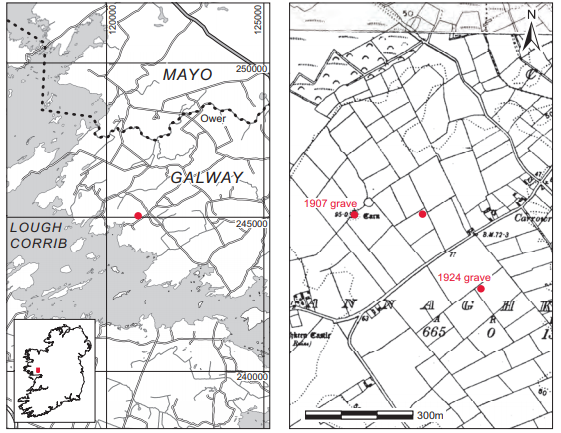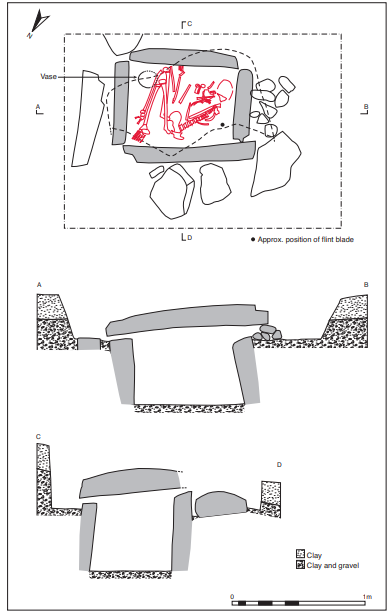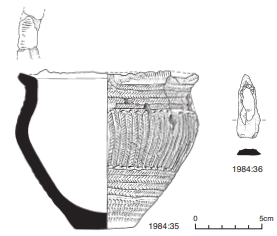County: Galway Site name: ANNAGHKEEN, CO. GALWAY
Sites and Monuments Record No.: SMR GA055-008 Licence number: E1068
Author: RAGHNALL Ó FLOINN
Site type: Early Bronze Age graves
Period/Dating: —
ITM: E 520977m, N 745072m
Latitude, Longitude (decimal degrees): 53.449799, -9.189661
Introduction
In May 1984 a short cist containing an inhumation accompanied by a vase, a flint blade and some pig bones was discovered near Ower, Co. Galway. The discovery was made during ploughing and the landowner, on finding the capstone approximately 0.1m below the surface, thought that it was a natural stone and attempted to break it up with a sledgehammer.

The site was reported to the NMI by Percy Lovegrove of An Córas Tráchtála, and a two-day rescue excavation was undertaken by Raghnall Ó Floinn. The human remains from the site were analysed by Barra Ó Donnabháin.
Location (Fig. 3.69)
The cist was in the townland of Annaghkeen, mid-Co. Galway, approximately 6km south-west of Headford and 1km north-east of the eastern shore of Lough Corrib.101 The site was on the edge of a break of slope in a field, which sloped from south-east to north-west, between 15m and 30m above sea level. A cemetery cairn, investigated in 1907, is located approximately 30m to the west on high ground (SMR GA055-001——), and 30m to the south-east is the site of another cemetery cairn, investigated in 1924 (SMR GA055-006——; Costello 1907–8, 159).
Description of site
An area measuring 2m by 1.5m around the cist was cleared but the edge of the pit was not located. The northern edge of the capstone was broken off when investigated and it had been shifted slightly to the north and west of its original position. The cist was short and trapezoidal in plan, with its long axis aligned north-east/south-west. Internally, it measured 0.8m long by 0.62m wide by 0.55m high (Fig. 3.70). It was constructed of four split limestone slabs set on edge, one at each wall, with the straight edges facing inwards. There was evidence for the use of packing stones in the fill of the pit. Outside the east wall of the cist and set at an angle to it was a limestone slab, 0.72m long by 0.13–0.16m in width. A large boulder, at least 0.3m wide, was set outside the south-eastern corner of the cist. Two boulders, 0.35m by 0.42m and 0.25m by 0.3m, were set outside the northern wall, and a large boulder with concave upper surfaces, 0.55m by 0.28m, was placed outside the eastern corner. A series of pebbles occurred outside the western side of the cist and the capstone rested on these rather than on the side stone. The damaged capstone, irregular in outline, measured 2.34m long and survived to a maximum width of 1.6m. It consisted of a split limestone slab with an even lower face, the upper face pitted with solution holes and slightly domed. The floor of the cist was not paved but was formed of naturally occurring gravel.
The cist contained a crouched inhumation of a juvenile accompanied by a vase, a flint blade, mussel shells and some pig bone, which was found among the human bone.102 The interior of the cist, including the grave floor, skeleton and grave-goods, was covered with a lime deposit formed by the reaction of rainwater with the limestone capstone. It was clear that no soil had accumulated in the cist prior to its discovery. The skull and vase had been disturbed in the course of discovery and some of the bones were not in their original positions. The skeleton (1984:34), the remains of a juvenile aged 14–15 years, lay on its right side in a flexed position with the head in the southern corner and the feet towards the north. One arm lay roughly parallel with the femur, the other apparently flexed upwards towards the face. The vase was in the eastern corner of the cist beside the flexed knees. It lay mouth upwards, tilted slightly to the north. A small flint knife was discovered in the western corner of the cist. The covering of lime on its surface indicated that it originally lay on the floor of the cist. A number of mussel shells were also found on the floor of the cist.103
Bipartite vase, 1984:35 (Fig. 3.71)
Approximately three quarters of the vessel survive. It is decorated with very finely executed


incised herringbone patterns. The neck is decorated with four rows of incised lines forming a herringbone motif, and the body is decorated with a series of vertical lines of incised herringbone. Below this the rows of herringbone decoration on the neck are repeated. The final band of decoration on the vessel consists of a series of rows of very small fingernail impressions, each row in alternating direction to the next. The base of the vessel is plain.
Dimensions: H 11.8cm; ext. D rim 14.4cm; D base 5.1cm; T wall 0.85cm.
Flint blade, 1984:36104 (Fig. 3.71)
Flint, or possibly chert, blade; tertiary flake. Triangular in outline and trapezoidal in crosssection, narrowing from the striking platform to the tip. The long sides and point are retouched on one face. The bulb of percussion is prominent.
Dimensions: max. L 4.68cm; max. T 0.57mm; max. W 2.11cm; W at bulbar end 1.7cm.
Comment
Two samples from this cist were dated. The first date, of 4210±60 BP,105 was obtained from collagen and has been dismissed as too old (Brindley 2007, 85). A second sample, also from collagen, produced a date of 3440±70 BP, which calibrates to 1937–1537 BC at 95.4% probability.106 This is amongst the latest dates for the vase type quoted by Brindley, although, with its particular type of banded decoration, the vase from Annaghkeen seems more like stage 1 vases than later types. Collagen from the cist containing the ribbed bowl (1932:6525) produced a date of 3660±25 BP (Brindley 2007, 59), which calibrates to 2140–1950 BC at 95.4% probability and places it within the stage 2 period of bowl development, dated by Brindley (2007, 247, 328) to 2080–1980 BC, centring on 2030 BC.107
This cist and its contents were located in an area of the townland of Annaghkeen where several other Bronze Age burial monuments are recorded. The presence of a mussel shell is another example of this type of occasional discovery in burials of the period. As Annaghkeen is very close to the western shores of Lough Corrib this is not surprising. The presence of unburnt pig bones, identified as a radius and an ulna, is also significant as these may represent an offering of food to accompany the spirit of the deceased. The archaeological inventory for County Galway records details of a cairn (1027), a tumulus (1028), another tumulus (1029) and a pit burial (1031), as well as the site under discussion (1030; Alcock et al. 1999, 4). All except site 1029 have produced evidence of Bronze Age burials. The cairn was partially demolished by quarrying in 1907. A large rectangular cist was found which contained a lidded vase, a miniature vase, some other sherds of pottery, a small bronze dagger, a bronze awl and a quartz pebble, together with a deposit of cremated bones108 (Ó Ríordáin and Waddell 1993, 110).
The tumulus (1029) was investigated in 1924. A rectangular cist was found which contained the skeletons of an adult male and a child, and a ribbed bowl109 (Ó Ríordáin and Waddell 1993, 110). It has been recorded also that a pit burial (1031) containing an urn and cremated remains was found a few hundred metres from the tumulus c. 1909 (Costello 1922–3, 118). Nothing survives of this discovery
Clearly, there was a complex of early Bronze Age funerary monuments in close proximity to one another. It is unfortunate that no details of the urn said to have been found in 1909 have survived, as its typology might enable some comment to be made on a date for the pit burial in which it was found. Although only two dates are available for the complex of monuments, they and the various pottery types suggest that the sites were in use over a significant period of years. The cist excavated in 1907 was a very rich burial by comparison with most others, while the one excavated in 1984 also produced unusual animal and shell remains.
HUMAN REMAINS
BARRA Ó DONNABHÁIN
Introduction
The remains (1984:34) are well preserved and the skeleton is mostly complete. The skull was broken after the discovery of the cist, and the frontal bone and some of the facial skeleton were probably lost at this time. All of the long bones were recovered, though some are in a fragmentary state. Four of the cervical vertebrae and all of the thoracic, lumbar and sacral elements were recovered. Most of the ribs and some of the bones of the hands and feet are also present.
Age and sex
A combination of epiphyseal and dental evidence suggests that this individual was aged about 14–15 years at the time of death. It is not generally possible to determine the sex of non-adults from their skeletal remains.
Teeth
The following teeth were present and in occlusion at the time of death:

The portions of the maxillae and mandibles that contained the remaining teeth were not recovered.
The only anomaly encountered in these remains concerned the third molars. The lower of these were developing normally, and at the time of death enamel formation was complete.Enamel formation was also complete on the upper third molars but these were peg-shaped. This anomaly has been reported in all modern populations (Bass 1971) but this example appears to be the first incidence in a Bronze Age Irish group. In modern groups, peg-shaped teeth occur most frequently in the genetically unstable third molars (Bass 1987). This Bronze Age example follows this pattern.
Pathology
No pathological changes were noted in these remains.
Animal remains
The remains from the cist also contained the unburnt left(?) radius and ulna of a juvenile pig.
GEOLOGICAL REPORT
J.S. JACKSON
Pottery
Loose fragments including quartz and many pieces that contain euhedral crystals of pyrite and some chalcopyrite (mixed sulphide of copper and iron). At least four fragments. Also black chert; some pyrite crystals are up to 2mm across. Also charcoal fragments. The provenance is probably Lower Carboniferous (Tournaisian), with mineralisation containing iron and copper sulphides and even quartz. Such mineralisation is known across Lough Corrib, near Oughterard, and may conceivably occur in the vicinity of Headford. Black chert would be consistent with such a provenance. All these ingredients could occur as erratics in the soil. Some sherds show advanced vitrification, occurring as black glass, and either the firing temperature was very high or fluxes were present in the clay. Precipitated lime is abundant and it occurs as a coating on most of the fragments examined.
Flint blade
The material is either flint or possibly pale-coloured chert. It is coated in precipitated lime. If chert, the provenance could be relatively local, i.e. in the vicinity of Headford, etc. If flint, it is difficult to reconcile with a possible glacial erratic provenance.
101. Parish of Killursa, barony of Clare. SMR GA055-008——. IGR 121010 245048.
102. Human remains 1984:34; vase 1984:35; flint blade 1984:36. As the pig bones were only found as a result of
the analysis of the human remains, they were not given a separate register number.
103.1984:37.
104. Description courtesy of Dr Aimée Little.
105. GrN-13580.
106. OxA-2665.
107. GrN-11355. This vessel is referred to as ‘Annaghkeen 24’ by Brindley (2007).
108. SA1908:13–20.
109. 1932:6525.